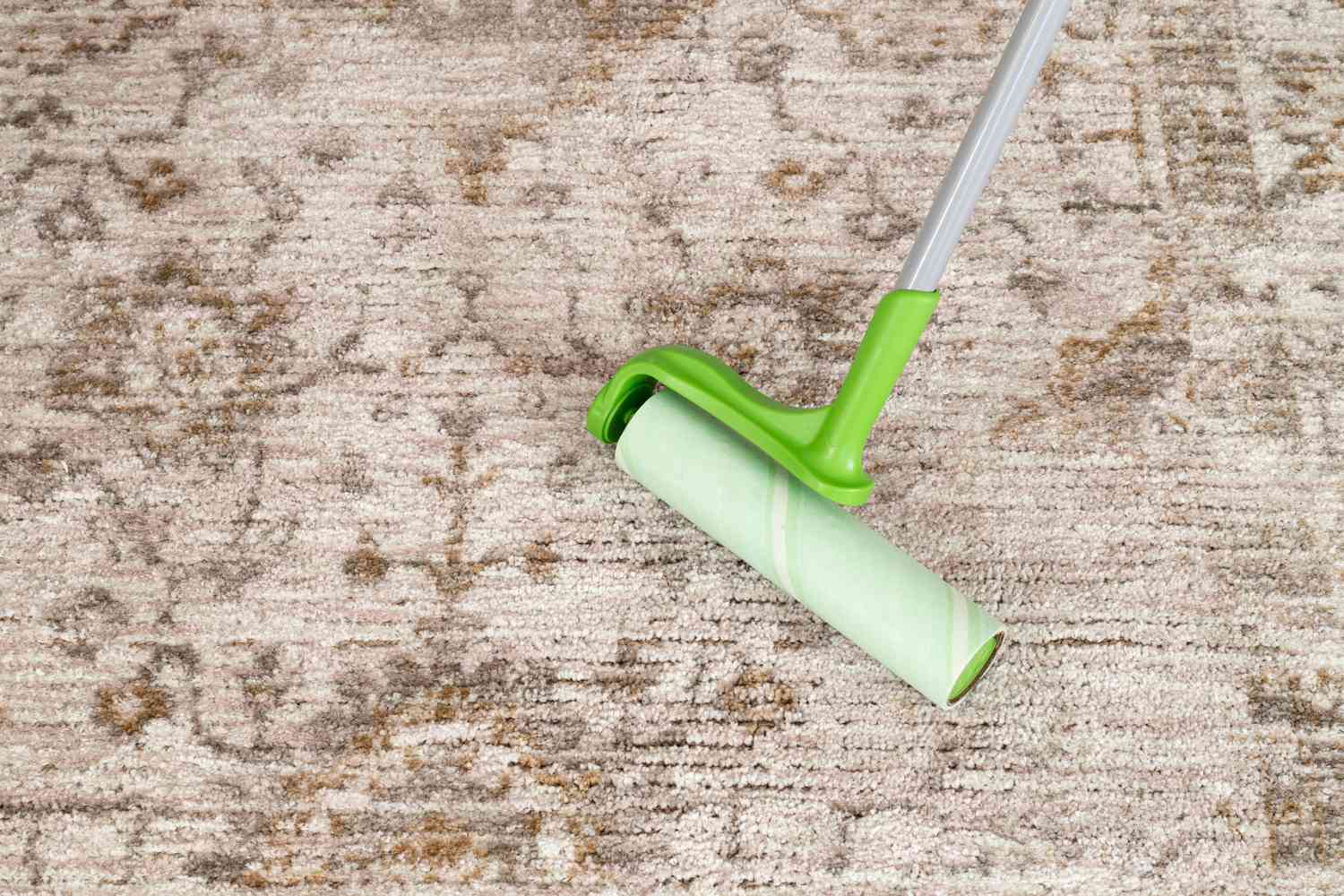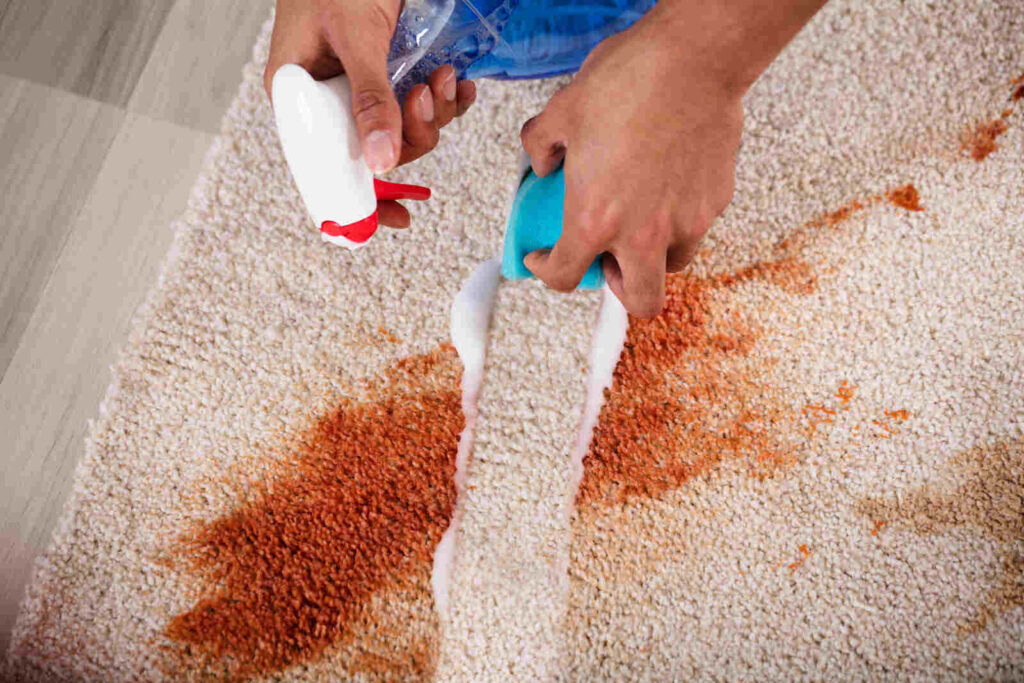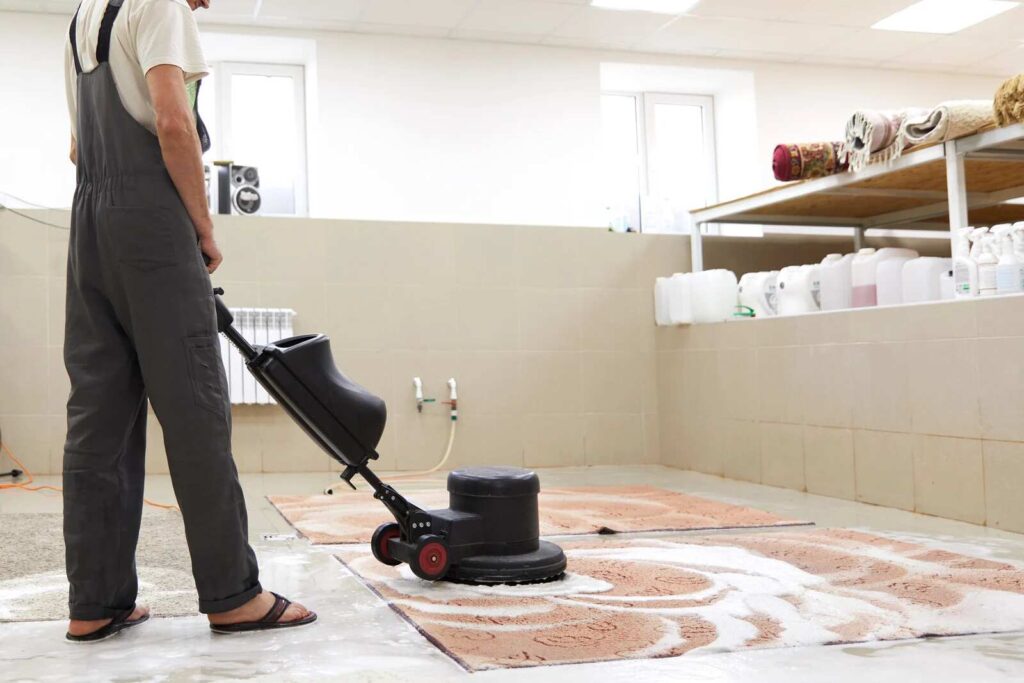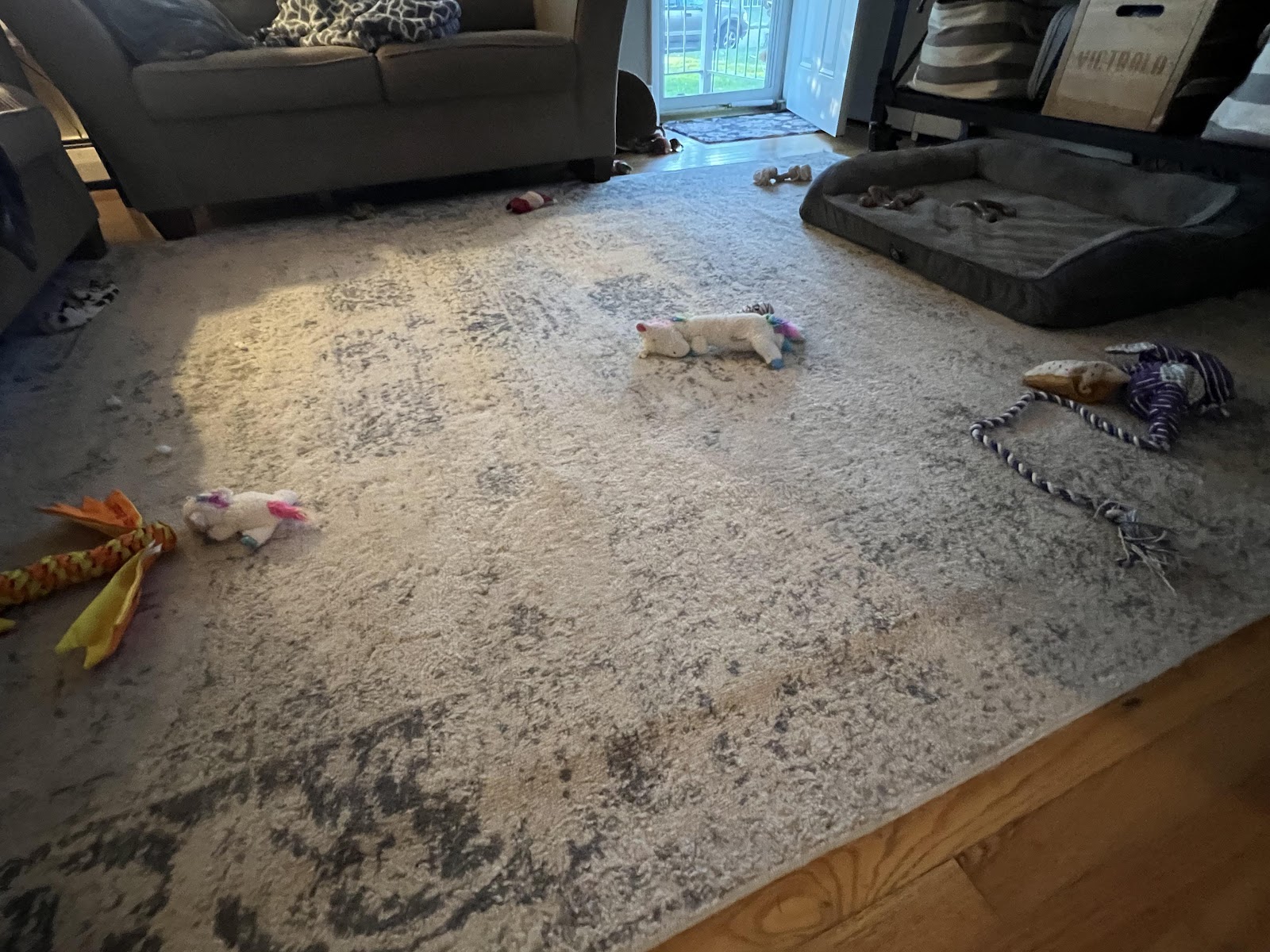Cleaning a rug without a carpet cleaner is easy. You can do it with simple household items.
Rugs can get dirty quickly. Spills, dirt, and everyday use can make them look worn. You don’t always need a fancy carpet cleaner. Some basic tools and a little effort can make your rug look new again. In this guide, we’ll show you how to clean a rug using items you already have at home.
It’s simple, cost-effective, and works well. Whether you have a small area rug or a large carpet, these steps will help you keep it fresh and clean. Ready to get started? Let’s dive in and make your rug look great!

Essential Supplies Needed
Cleaning a rug without a carpet cleaner can be easy and effective if you have the right supplies. Using common household items and a bit of elbow grease, you can keep your rug looking fresh and clean. Here are the essential supplies you’ll need.
To Get The Best Rug Cleaning Service – Click Here
Cleaning Solutions
For effective rug cleaning, having the right cleaning solutions is crucial. Here are some simple yet powerful solutions you can use:
- White Vinegar and Water: Mix equal parts of white vinegar and water in a spray bottle. This solution helps remove stains and neutralize odors.
- Baking Soda: Sprinkle baking soda over the rug. It absorbs odors and helps loosen dirt.
- Mild Detergent: Use a small amount of mild liquid detergent mixed with warm water. This is great for spot cleaning.
- Hydrogen Peroxide: For tough stains, mix one part hydrogen peroxide with two parts water. Test on a small area first to ensure it doesn’t bleach the rug.
| Cleaning Solution | Purpose | Usage |
| White Vinegar and Water | Stain removal and odor neutralization | Spray and blot with a cloth |
| Baking Soda | Odor absorption and dirt loosening | Sprinkle, let sit, then vacuum |
| Mild Detergent | Spot cleaning | Apply with a sponge and blot |
| Hydrogen Peroxide | Tough stain removal | Apply, let sit, then blot |
Tools For Cleaning
Having the right tools makes the cleaning process much easier. Here are the essential tools you’ll need:
- Vacuum Cleaner: A vacuum cleaner with a brush attachment helps remove loose dirt and debris from the rug.
- Soft-Bristle Brush: Use this to gently scrub the rug without damaging the fibers.
- Microfiber Cloths: These are excellent for blotting stains and applying cleaning solutions.
- Bucket: A bucket is useful for mixing cleaning solutions and rinsing your tools.
- Sponge: A sponge is handy for applying mild detergent to stained areas.
Here is a breakdown of the essential tools:
| Tool | Purpose |
| Vacuum Cleaner | Remove loose dirt and debris |
| Soft-Bristle Brush | Gentle scrubbing |
| Microfiber Cloths | Blotting and applying solutions |
| Bucket | Mixing and rinsing |
| Sponge | Applying detergent |
With these cleaning solutions and tools, you can effectively clean your rug without a carpet cleaner. Proper preparation and the right supplies will make the task easier and ensure your rug stays in good condition.
Pre-cleaning Preparations
Cleaning a rug without a carpet cleaner might seem challenging, but with the right steps, it’s quite manageable. The first and most crucial part is the pre-cleaning preparations. Proper preparation ensures that the cleaning process is effective and that your rug remains in good condition. This section will guide you through the essential pre-cleaning steps to get your rug ready for a thorough clean.
To Get The Best Rug Cleaning Service – Click Here
Vacuuming The Rug
Before any deep cleaning, vacuuming the rug is essential. This step removes loose dirt, dust, and debris that can interfere with the cleaning process. Here’s how to do it effectively:
- Choose the right vacuum attachment: Use a vacuum cleaner with a brush attachment to ensure gentle cleaning. Avoid using beater bars or rotating brushes on delicate rugs.
- Vacuum both sides: Start by vacuuming the top side of the rug thoroughly. Make sure to go over each section multiple times. Then, flip the rug and vacuum the underside. This helps remove dirt that might be trapped in the fibers.
- Pay attention to edges and corners: Dirt often accumulates in the edges and corners of the rug. Use the vacuum’s crevice tool to reach these areas.
For a more detailed approach, consider using a table to outline the steps:
| Step | Description |
| Select Attachment | Choose a brush attachment for gentle cleaning. |
| Vacuum Top Side | Thoroughly vacuum the top side, covering all areas. |
| Flip and Vacuum | Turn the rug over and vacuum the underside. |
| Clean Edges | Use the crevice tool to clean edges and corners. |
Regular vacuuming is crucial. It helps maintain the rug’s appearance and prolongs its lifespan. Always vacuum in the direction of the rug’s fibers to avoid damage.
Spot Testing
Spot testing is another essential pre-cleaning step. This ensures that the cleaning solution won’t damage or discolor your rug. Follow these steps for effective spot testing:
- Choose a hidden area: Select a small, inconspicuous spot on the rug, like a corner or under furniture.
- Apply the cleaner: Use a small amount of the cleaning solution you plan to use. Dab it onto the chosen spot with a clean cloth.
- Wait and observe: Allow the solution to sit for about 15 minutes. Check for any color changes or fabric damage.
If you notice any adverse effects, avoid using that cleaner on the entire rug. Instead, consider using a milder solution or consulting a professional. For better clarity, refer to the table below:
| Step | Description |
| Select Test Area | Choose a hidden area on the rug. |
| Apply Cleaner | Use a small amount of the cleaning solution. |
| Wait and Check | Observe the spot for 15 minutes for any changes. |
Spot testing is a critical step. It ensures that your rug remains undamaged and maintains its color and texture. Always perform this test before proceeding with the full cleaning.
Homemade Cleaning Solutions
Cleaning a rug without a carpet cleaner can be easy and effective with homemade cleaning solutions. These solutions use common household items, making them cost-effective and safe. Let’s explore some simple yet powerful homemade cleaning solutions.
Vinegar And Water Mix
A vinegar and water mix is a classic cleaning solution. It’s effective for removing stains and deodorizing your rug. Here’s how you can use it:
- Mix equal parts of white vinegar and water in a spray bottle.
- Spray the solution onto the stained area of the rug.
- Let it sit for 5-10 minutes to break down the stain.
- Blot the area with a clean cloth to lift the stain.
- Repeat if necessary until the stain is gone.
- Allow the rug to air dry completely.
This mix works well on most stains, including food spills and pet accidents. The vinegar helps to neutralize odors, leaving your rug smelling fresh. You can use this solution for regular cleaning or spot cleaning as needed.
For a deeper clean, consider using a scrubbing brush. Gently scrub the stained area after applying the vinegar and water mix. This helps to lift dirt and grime embedded in the rug fibers. Be careful not to use too much force to avoid damaging the rug.
If you have a sensitive nose, you may notice the vinegar smell initially. Don’t worry, as the smell dissipates as the rug dries. For added fragrance, you can add a few drops of essential oil to the mix. Lavender or lemon oil works well and adds a pleasant scent.
Baking Soda Paste
Baking soda is a versatile cleaning agent. It’s great for tackling tough stains and odors. Here’s how to make a baking soda paste:
- Mix 3 parts baking soda with 1 part water in a bowl.
- Stir until it forms a thick paste.
- Apply the paste to the stained area of the rug.
- Let it sit for 15-20 minutes to absorb the stain.
- Use a brush to scrub the paste into the rug fibers.
- Blot with a damp cloth to remove the paste.
- Allow the rug to dry completely.
Baking soda is excellent for removing stains like grease, wine, and pet urine. It also helps to neutralize odors, making your rug smell clean. For tougher stains, you can leave the paste on for a longer period before scrubbing.
For added cleaning power, you can combine baking soda with vinegar. Sprinkle baking soda on the stained area, then spray with vinegar and water mix. The reaction between baking soda and vinegar helps to lift stubborn stains.
After cleaning, vacuum the rug to remove any remaining baking soda residue. This ensures your rug feels fresh and clean. Baking soda is safe for most rug materials, but always test a small area first.
Using homemade cleaning solutions is a simple and effective way to keep your rug clean without harsh chemicals. They are safe, eco-friendly, and easy to make with items you already have at home.

Deep Cleaning Techniques
Cleaning a rug without a carpet cleaner might seem challenging, but with the right techniques, it’s entirely doable. Deep cleaning your rug can help remove dirt, stains, and odors, making your home feel fresh and clean. Let’s dive into effective deep cleaning techniques for your rug.
Scrubbing Methods
Scrubbing your rug is a crucial part of deep cleaning. Here are some steps to follow:
- Vacuum the rug: Start by vacuuming the rug thoroughly to remove loose dirt and debris. This step helps prevent the dirt from getting embedded deeper into the fibers when you start scrubbing.
- Prepare a cleaning solution: Mix a mild detergent with warm water. Avoid using hot water as it can damage the rug fibers.
- Test a small area: Before applying the solution to the entire rug, test it on a small, inconspicuous area to ensure it doesn’t cause any discoloration or damage.
- Scrub gently: Use a soft-bristled brush to scrub the rug gently. Work in small sections, scrubbing in a circular motion. Focus on heavily soiled areas but be careful not to scrub too harshly to avoid damaging the fibers.
- Blot the stains: For stubborn stains, use a clean cloth or sponge to blot the area instead of scrubbing. This helps lift the stain without spreading it.
Using the right scrubbing method can make a significant difference in how clean your rug looks and feels. Always remember to handle the rug gently to maintain its quality.
Rinsing The Rug
Rinsing your rug properly is essential to remove any soap residue and avoid mold growth. Follow these steps for effective rinsing:
- Use clean water: Fill a bucket with clean, cold water. Avoid using hot water as it can shrink or damage the rug fibers.
- Rinse in sections: Rinse the rug in small sections to ensure all the soap is removed. Use a clean cloth or sponge to apply the water and gently blot the area.
- Remove excess water: After rinsing each section, use a dry towel to blot and absorb excess water. This helps speed up the drying process.
- Repeat if necessary: If you notice any remaining soap residue, repeat the rinsing process until the water runs clear.
- Dry the rug: Lay the rug flat in a well-ventilated area to dry. Avoid direct sunlight as it can cause fading. Ensure the rug is completely dry before placing it back in your home to prevent mold and mildew.
Proper rinsing ensures that your rug stays clean and fresh without any leftover soap residue. Taking the time to rinse thoroughly will extend the life of your rug and keep it looking its best.
Dealing With Stains
Rugs can make a room cozy and beautiful, but they also attract stains. Cleaning a rug without a carpet cleaner might seem challenging. Don’t worry! With some simple techniques and household items, you can handle most stains yourself. Let’s explore how to deal with stains effectively.
To Get The Best Rug Cleaning Service – Click Here
Common Stain Removal Tips
Accidents happen, and rugs often bear the brunt. For common stains, quick action is key. Here are some tips to tackle everyday spills and stains:
- Blot, Don’t Rub: Immediately blot the stain with a clean cloth. Rubbing can spread the stain.
- Use Cold Water: For most stains, cold water works best. Hot water might set the stain.
- Mild Detergent: Mix a few drops of mild dish soap with water. Dab the stain gently with this solution.
- Vinegar Solution: A mix of equal parts white vinegar and water can help with tougher stains. Test on a small area first.
- Baking Soda: Sprinkle baking soda over the stain. Let it sit for a few hours, then vacuum it up. This can absorb odors and moisture.
Here’s a quick reference table for common stains:
| Stain Type | Cleaning Method |
| Food Spills | Blot with cold water, then use mild detergent. |
| Pet Accidents | Blot, then use vinegar solution and baking soda. |
| Wine | Blot with cold water, then apply vinegar solution. |
| Ink | Blot with rubbing alcohol, then rinse with cold water. |
Specialized Stain Solutions
Some stains need special attention. Here are solutions for those tricky stains that don’t come out with common methods:
- Grease Stains: Sprinkle cornstarch or talcum powder over the stain. Let it sit for a few hours to absorb the grease. Vacuum it up and blot with a dish soap solution.
- Blood Stains: Use cold water and salt. Mix salt with cold water to make a paste. Apply to the stain, let it sit, then blot with a clean cloth.
- Coffee/Tea Stains: Blot with cold water first. Then, mix white vinegar with a bit of dish soap and water. Dab the stain with this mixture.
- Gum: Freeze the gum with ice cubes in a plastic bag. Once hardened, scrape it off gently with a dull knife.
- Wax: Place a brown paper bag over the wax stain. Use a warm iron over the bag to melt the wax, which the bag will absorb.
These specialized solutions can handle even the toughest stains. Remember, always test any cleaning solution on a small, hidden area of the rug first. This ensures the solution won’t damage the fibers or colors.
Drying The Rug Properly
Cleaning a rug without a carpet cleaner can be a straightforward task if you follow the right steps. One of the most critical steps is drying the rug properly. Proper drying prevents mold, mildew, and unpleasant odors. Let’s explore the best ways to dry your rug to keep it fresh and clean.

Air Drying Tips
Air drying is an effective and natural way to dry your rug. Here are some tips to ensure your rug dries thoroughly:
- Find a Flat Surface: Lay your rug flat on a clean, dry surface. This helps it dry evenly and prevents any warping.
- Use Fans: Place fans around the rug to increase air circulation. This speeds up the drying process.
- Elevate the Rug: If possible, elevate the rug slightly off the ground using bricks or other objects. This allows air to flow underneath.
- Turn the Rug: Flip the rug periodically to ensure both sides dry completely.
- Check for Damp Spots: Feel the rug periodically to check for any damp spots that may need more time to dry.
| Drying Tip | Benefit |
| Find a Flat Surface | Ensures even drying and prevents warping |
| Use Fans | Increases air circulation and speeds up drying |
| Elevate the Rug | Allows air to flow underneath for thorough drying |
| Turn the Rug | Ensures both sides dry completely |
| Check for Damp Spots | Identifies areas that need more drying time |
Avoiding Sunlight Damage
While sunlight can help dry your rug, too much exposure can cause damage. Here are some ways to avoid sunlight damage:
- Indirect Sunlight: Place the rug in an area with indirect sunlight. Direct sunlight can fade colors and weaken fibers.
- Use Curtains or Blinds: If drying indoors, use curtains or blinds to filter the sunlight. This reduces the risk of damage.
- Limit Exposure Time: Avoid leaving the rug in sunlight for extended periods. A few hours a day is sufficient.
- Rotate the Rug: If drying outdoors, rotate the rug periodically. This ensures even exposure and prevents one side from getting too much sun.
- Shade Cloth: Use a shade cloth to cover the rug. This provides protection while still allowing air to flow.
By following these tips, you can dry your rug efficiently without risking sunlight damage. Keeping your rug out of direct sunlight helps maintain its color and strength.
Maintaining Rug Freshness
Cleaning a rug without a carpet cleaner can be challenging, but it is essential to maintain its freshness. A fresh rug not only looks good but also contributes to a healthy home environment. Proper care and maintenance can prolong the life of your rug, keeping it clean and odor-free.
Regular Cleaning Schedule
Consistency is key to maintaining your rug’s freshness. Establishing a regular cleaning schedule helps prevent dirt and dust from embedding deep into the fibers. Follow these steps to keep your rug in top condition:
- Vacuum Frequently: Vacuum your rug at least twice a week. Use a vacuum with a brush attachment to lift dirt and debris.
- Shake it Out: Take your rug outside and shake it vigorously. This removes loose dirt and dust particles.
- Spot Clean: Attend to spills and stains immediately. Use a mild detergent and a damp cloth to blot the affected area.
- Flip and Rotate: Every few months, flip and rotate your rug to ensure even wear and tear.
- Deep Clean: Perform a deep clean every six months using a mixture of water and mild detergent. Scrub gently with a soft brush and rinse thoroughly.
Following a regular cleaning schedule ensures your rug remains fresh and clean, reducing the accumulation of allergens and dust mites. Consistent care also helps maintain the rug’s appearance and texture.
Deodorizing Tips
To keep your rug smelling fresh, deodorizing is essential. Unpleasant odors can build up over time, especially in high-traffic areas. Here are some effective deodorizing tips:
- Baking Soda: Sprinkle a generous amount of baking soda over your rug. Let it sit for at least 30 minutes, then vacuum it up. Baking soda absorbs odors and leaves your rug smelling fresh.
- Vinegar Solution: Mix equal parts water and white vinegar in a spray bottle. Lightly mist your rug with the solution and let it air dry. Vinegar neutralizes odors without leaving a strong smell.
- Essential Oils: Add a few drops of your favorite essential oil to a spray bottle filled with water. Lightly mist the rug for a pleasant aroma. Lavender, eucalyptus, and lemon oils are good choices.
- Sunlight: Take your rug outside and let it bask in the sunlight for a few hours. Sunlight helps eliminate odors and kills bacteria.
- Homemade Carpet Freshener: Mix one cup of baking soda with a few drops of essential oil. Sprinkle the mixture over your rug, let it sit for 30 minutes, then vacuum it up.
By incorporating these deodorizing tips into your cleaning routine, you can keep your rug smelling fresh and inviting. Regular deodorizing prevents the buildup of unpleasant odors, ensuring a clean and pleasant home environment.
Handling Different Rug Materials
Cleaning a rug without a carpet cleaner can be a manageable task with the right approach. Different rug materials require different cleaning techniques to ensure they remain in good condition. Understanding how to handle each type of material is crucial for effective cleaning. Let’s explore the best methods for cleaning wool and synthetic rugs.
To Get The Best Rug Cleaning Service – Click Here
Wool Rugs
Wool rugs are known for their durability and natural beauty. They require gentle care to maintain their appearance and longevity. Follow these steps to clean a wool rug effectively:
- Shake and Beat: Take the rug outside and give it a good shake to remove loose dirt. Hang it over a sturdy line or railing and beat it with a broom handle to dislodge embedded dust.
- Vacuum: Use a vacuum cleaner with a gentle brush attachment. Vacuum both sides of the rug. Be careful around the edges and fringes to avoid damage.
- Spot Clean: Mix a mild detergent with water. Test on a small, inconspicuous area first. Dab the solution onto stains using a clean cloth. Rinse with a damp cloth and blot dry.
- Dry: Lay the rug flat in a well-ventilated area. Avoid direct sunlight, which can fade colors.
Here’s a quick reference table for wool rug cleaning:
| Step | Description |
| Shake and Beat | Remove loose dirt and dust. |
| Vacuum | Use a gentle brush attachment. |
| Spot Clean | Test the detergent and dab on stains. |
| Dry | Lay flat in a shaded, ventilated area. |
Synthetic Rugs
Synthetic rugs are made from materials like nylon, polyester, or olefin. They are more stain-resistant and easier to clean than wool rugs. Follow these steps for cleaning synthetic rugs:
- Shake and Vacuum: Shake the rug outside to remove loose dirt. Vacuum both sides thoroughly, paying attention to high-traffic areas.
- Spot Clean: Mix a solution of water and a small amount of mild detergent. Test the solution on a small area first. Use a sponge or cloth to apply the solution to stains, working from the outside in to avoid spreading.
- Rinse: Rinse the cleaned areas with a damp cloth to remove any soap residue. Blot with a dry towel to absorb excess moisture.
- Deep Clean: For a deeper clean, mix one part white vinegar with three parts water. Apply to the rug using a sponge. Rinse and blot dry.
- Dry: Hang the rug to dry or lay it flat in a well-ventilated area. Ensure it dries completely to prevent mold.
Here’s a quick reference table for synthetic rug cleaning:
| Step | Description |
| Shake and Vacuum | Remove loose dirt and dust. |
| Spot Clean | Test the detergent and dab on stains. |
| Rinse | Remove soap residue with a damp cloth. |
| Deep Clean | Use vinegar solution for deeper cleaning. |
| Dry | Hang or lay flat to dry completely. |
Preventing Future Dirt Build-up
Cleaning a rug without a carpet cleaner can be a challenge. But, preventing future dirt build-up can make it much easier. By following some simple tips, you can keep your rug looking fresh and clean for longer. Let’s explore some effective strategies.
Rug Placement Tips
Where you place your rug matters. Correct placement can reduce dirt build-up. Here are some tips to consider:
- Avoid High-Traffic Areas: Place your rug away from busy areas like hallways or entrances. These areas see a lot of foot traffic, which can lead to more dirt.
- Use Furniture to Your Advantage: Place rugs under furniture. This can protect parts of the rug from direct exposure to dirt.
- Rotate Regularly: Rotate your rug every few months. This helps in even wear and prevents dirt from settling in one spot.
- Keep Away from Windows: Direct sunlight can fade colors and weaken fibers. Place the rug in a shaded area.
Consider the type of rug and its material when placing it. For example, delicate rugs should be kept in low-traffic areas. Below is a simple table to illustrate:
| Rug Type | Recommended Placement |
| Wool Rug | Living Room |
| Silk Rug | Bedroom |
| Synthetic Rug | Hallway |
Use Of Doormats
Doormats are your first line of defense against dirt. They trap dirt before it reaches your rug. Here’s how to make the best use of doormats:
- Place Doormats at Every Entrance: Put doormats outside and inside all entrances. This will reduce the amount of dirt that gets inside.
- Choose the Right Material: Use coarse-textured doormats. These are more effective at scraping dirt off shoes.
- Clean Doormats Regularly: Shake out or vacuum your doormats weekly. A dirty doormat can’t trap dirt effectively.
- Encourage Shoe Removal: Have a no-shoes policy inside. Provide a shoe rack near the entrance to encourage this habit.
Using doormats strategically can make a big difference. Below is a quick checklist to ensure you’re using them effectively:
- Doormats at all entrances?
- Coarse-textured doormats?
- Regular cleaning of doormats?
- Shoe rack available?
By following these tips, you can significantly reduce the amount of dirt that reaches your rug. This makes cleaning easier and keeps your rug looking great.

When To Seek Professional Help
Cleaning a rug without a carpet cleaner is possible with the right methods. Still, there are times when seeking professional help is necessary. Understanding when to call in the experts can save your rug from further damage and ensure it remains in good condition. Let’s explore the signs that indicate it’s time to seek professional help and how to find the right experts for the job.
To Get The Best Rug Cleaning Service – Click Here
Signs Of Damage
Sometimes, cleaning a rug yourself might not be enough. Here are a few signs that your rug might be damaged and require professional attention:
- Discoloration: If you notice uneven or faded spots, it may indicate damage that needs professional care.
- Persistent Stains: Stains that don’t go away with regular cleaning might need special treatment.
- Odors: Lingering smells can be a sign of deep-seated dirt or mold.
- Fraying Edges: Frayed or worn edges can worsen if not handled properly.
- Loose Fibers: If the rug’s fibers are coming out, it might be a sign of structural damage.
It’s important to address these issues promptly. Ignoring them can lead to more severe damage. The following table highlights common problems and their potential consequences:
| Problem | Potential Consequence |
| Discoloration | Permanent fading and uneven appearance |
| Persistent Stains | Stains become harder to remove over time |
| Odors | Mold growth and health issues |
| Fraying Edges | Rug loses its shape and integrity |
| Loose Fibers | Structural damage and bald spots |
By recognizing these signs, you can decide whether professional help is needed to restore your rug’s beauty and functionality.
Consulting Experts
Once you identify that your rug needs professional care, finding the right expert is crucial. Here are some steps to help you:
- Research: Look for reputable rug cleaning companies in your area. Read reviews and ask for recommendations.
- Check Credentials: Ensure the company is certified and has experience with the type of rug you own.
- Request Quotes: Contact multiple companies for estimates. Compare their services and prices.
- Ask Questions: Inquire about their cleaning methods, turnaround time, and guarantees.
- Inspect Their Work: If possible, visit their facility to see their cleaning process.
It’s important to choose a professional who understands the specific needs of your rug. Different materials and designs require different cleaning techniques. Here are some points to consider:
- Material: Wool, silk, and synthetic rugs each need unique care.
- Age: Antique rugs may require more delicate handling.
- Design: Intricate patterns need careful cleaning to avoid damage.
Professional rug cleaners can provide specialized care that you might not achieve at home. They have the tools and expertise to handle delicate fabrics and difficult stains. By consulting experts, you ensure your rug is cleaned thoroughly and safely.
Frequently Asked Questions
How Do I Clean A Rug Without A Carpet Cleaner?
You can vacuum, spot clean with mild detergent, and air dry your rug.
What Household Items Can I Use To Clean My Rug?
You can use baking soda, vinegar, and mild dish soap to clean your rug.
Can Baking Soda Clean A Rug?
Yes, sprinkle baking soda, let it sit, then vacuum to remove dirt and odor.
How Do I Remove Stains From My Rug Without A Cleaner?
Blot the stain with a mixture of water and dish soap, then rinse and dry.
Conclusion
Cleaning a rug without a carpet cleaner is simple and effective. Use basic tools and natural products for best results. Regular upkeep keeps your rug fresh and bright. Follow these easy steps to keep your rug looking good. Your rug can stay clean and fresh without expensive cleaners.
Remember, consistent care helps maintain its beauty. Try these tips today and enjoy a cleaner home. Your rugs will thank you!
